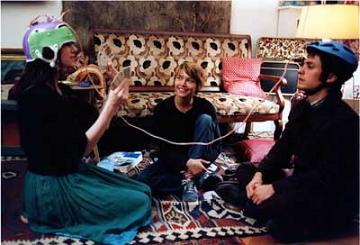

Watching a film by Michael Gondry can be an interesting and frustrating experience, mostly because his work is all over the place. Gondry is one of those directors who came to film after a career of directing music videos, so he has a flair for the visual. He also seems to gravitate towards unusual subjects. The first time he came to prominence was the horribly uneven Human Nature. Next was the vastly superior Eternal Sunshine of the Spotless Mind. Both of these, while directed by Gondry, bore the mark of the screenwriter extraordinaire Charlie Kaufman. After that came Dave Chappelle's Block Party, which documented Chappelle and a concert he threw. This was more of a documentary/extended music video, and at times it felt like the real vision behind things was Chappelle. With The Science of Sleep, Gondry has the chance to prove whether he can make it on his own or not. After all, he wrote and directed the movie.
The Science of Sleep is definitely unusual. The protagonist, Stephane (Gael Garcia Bernal, The King, Bad Education) has vivid dreams brought wonderfully to life, but has a hard time discerning the difference between his dreams and real life. He often drifts between the two, unaware that he is asleep. This allows for Gondry to do all sorts of wonderful things with blue screens and stop motion animation. But the focus was so squarely on making the atmosphere dream-like and weird that Gondry forgets to work on the story, which is a bit thin. Worse is that things sometimes come off as a bit unintentionally pretentious. Worst is that Stephane is a child in nearly all ways, including the fact that he is a bit annoying. It is difficult to enjoy and empathize with him when he acts like such a baby, especially when dealing with his neighbor Stephanie (Charlotte Gainsbourg, Happily Ever After, 21 Grams).
Stephane moved back to Paris after the death of his father. He is an artist, and thought he was going to get a job designing artwork for calendars. Instead, he is a glorified cut-and-paster, a job he finds dreadfully boring. His life changes for the better when Stephanie moves in next door. She is an artist, and according to her friend, has no boyfriend. Stephanie doesn't want a boyfriend either, but that doesn't stop Stephane from wooing her. First, she doesn't realize he lives next door, so he has to pretend to come from a distance away every time they meet. Their relationship is the bulk of the plot, the rest is a series of trips into Stephane's subconscious.
These are the most interesting parts of The Science of Sleep. Stephane often imagines that he is the emcee of Stephane TV, a talk show where he examines his own life. The television cameras are constructed of toilet paper rolls and cardboard boxes, and egg pieces of egg cartons line the walls. Behind his desk is a blue screen that also appears on the video wall behind him. Later, Stephanie appears in these dreams with him, apologizing for her actions in real life. In real life, Stephane hangs out with Stephanie, showing off inventions like 3D glasses that allow the wearer to see "real life in 3D" (get it?), a one-second time machine, and other assorted randomness. Everything meanders about, and Stephane's continual pining away at a love that seems destined to never actualize get extremely repetitive. The charm seems a bit forced, making everything feel a bit fake.